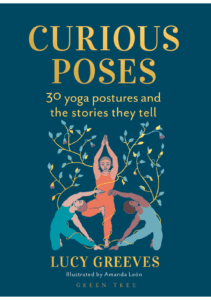
The meaning behind the asana
Come for the answers, stay for the questions: author Lucy Greeves thinks we should be more curious about the stories behind our favourite yoga poses
Yoga has an answer for everything – at least, if my bookshelf is to be believed. ‘Yoga for Emotional Balance’; ‘Yoga Against Spinal Pain’; ‘Yoga for Vital Beauty’…in line with the bold promise in its title, each book sets out a postural prescription to address your deficiencies.
One even has a ‘therapeutic index’ listing the poses you should use to treat a range of ailments, from adenoids to wind. The message is loud and clear: the asana is the answer.
But the more confidently an author claims to have the answers, the less I’m convinced. Of course, a great many yoga poses do have the potential to benefit us in specific ways – it’s just a shame to make that the end of the story.
Somebody once asked me what I wish I had known when I started my yoga studies, half a lifetime ago. I said I would tell my younger self: “You think yoga is going to give you all the answers. It’s not, but it will help you ask more interesting questions.”
For my new book, ‘Curious Poses: 30 Yoga Postures and the Stories They Tell’, I wanted to approach the poses as open-ended questions, rather than answers. I believe our experience of yoga asana can be so much deeper and richer if we allow ourselves to sit with the questions, contradictions and interwoven layers of meaning they contain.
Grappling with these questions may leave us temporarily confused and uncomfortable, but it can also lead us to a place where real growth and insight can be found.
I’d like to share just three examples of how we can use asana as a way into modern yoga’s most intriguing questions.

Warrior pose (Virabhadrasana):
Do yogis have to be nice all the time?
The Warrior sequence brings a flavour of martial arts onto the yoga mat. These big, confident standing poses can make you feel proud and uncompromising. They speak of decisive action: arms outstretched, making your presence felt in the world. It’s a world away from the more contemplative side of the practice.
The motif of yogi as warrior recurs throughout yoga’s history. Take the mythical warrior Virabhadra, vengeful slayer of Shiva’s enemies, or Arjuna, conflicted hero of the Bhagavad Gita.
Consider the militant sects who supplied yogis for hire as mercenaries in early modern India, and the resurgence of interest in yoga as military training for India’s independence movement in the 1930s. The idea of yoga as war-like doesn’t sit comfortably with the yogic precept of ahimsa (non-harming) or with modern, Western perceptions of the practice as a route to inner peace.
It’s a common workaround to reframe the Warrior’s battlefield as a metaphor for spiritual warfare: like Arjuna, we wield a sword of knowledge and slay our enemy, ignorance. But in practice, these bold, provocative poses can tap into something aggressive inside us that’s hard to entirely sanitise as metaphor. Sometimes it feels so good to stand proud and implacable, to inhabit a body that’s fired up and weaponised.
Arrogance, ruthlessness, dominance: a committed yoga practice doesn’t automatically immunise us against these more aggressive human traits. Is our practice about striving for balance, or learning to tolerate extremes? Should the goal be to stamp out our uglier traits, or look them square in the eye?
Sage Marichi’s Pose (Marichyasana):
How can we relate respectfully to the history and traditions of yoga?
The pose named for the sage Marichi requires you to fold your body into a deeply compressed shape, bound by your own arms. Although one of the Sanskrit meanings of marichi is ‘ray of light’, the stories told about this Hindu sage have more of a ‘malevolent narcissist’ vibe.

Marichi, a son of the creator god Brahma, lived with his wife Dharmavrata. One day he returned home extremely tired and told her to wash his feet for him. This scene was interrupted by the arrival of his father. In accordance with custom, Dharmavrata stopped washing her husband’s feet in order to welcome their divine guest.
Marichi was so enraged by this slight to his status that he immediately put a curse on his wife and turned her into stone. The god Vishnu later tried to rescue her, but the curse was too strong; she remained a rock for eternity.
Once you know the story behind the pose, it’s hard not to see something of the furious, clenched character of the husband in its knotted twists and binds. Or shades of the petrified wife, folded up into her stony prison.
And it raises the question: if these ancient, fearful stories are written into the poses, is it possible – or right or useful – to rewrite them? Is there an ‘authentic’ way to practice in which we exorcise the violent ghosts of yoga’s past and imbue the poses with a different sort of metaphor?
This points to a larger set of questions around how we might accommodate the many uncomfortable aspects of yoga’s long traditions within a modern frame. Can we find a way to honour the sources of this age-old practice without compromising our own ethics?

Tree Pose (Vrikshasana):
Is yoga supposed to hurt?
The original name for this pose is eka pada pranamasana – One-legged Prayer Pose. In the yoga tradition, it’s associated with extraordinary feats of endurance: various adepts are said to have held the pose for many days, months or even – in the case of the sage Bharigatha – as long as 1,000 years.
Such exercises were seen as the most powerful way to acquire tapas, a Sanskrit term that can be translated as austerity, ascetic power, discipline or heat. The theory was that a person who undertook long and painful physical penances would burn away karma (the effects of their actions on earth), allowing them to step off the wheel of rebirth and attain liberation.
But for those of us not so religiously invested in burning up karma, where does yogic discipline end and punishment begin? Should we too practice Tree Pose until it hurts, until our muscles and sinews grow wooden with disuse – or can we engage with a gentler form of asceticism that doesn’t require us to disown our own bodies?
After all, trees don’t punish themselves for 1,000 years. They just get on with being part of the forest. The question of whether yoga should cause us pain can be a fraught one. At one end of the spectrum, teachers may assure you that ‘pain is just resistance leaving the body’ — something you should embrace and work through. At the other end, they may promise you that everything you do in class should feel easeful and comfortable.
It’s clear the yoga tradition makes space for both: all the darkest shades of physical sensation are there, alongside states of intense ease and bliss. Navigating a path through these extremes is a matter of soul-searching and deliberate choice for each of us as we find our own way into the practice of yoga.





